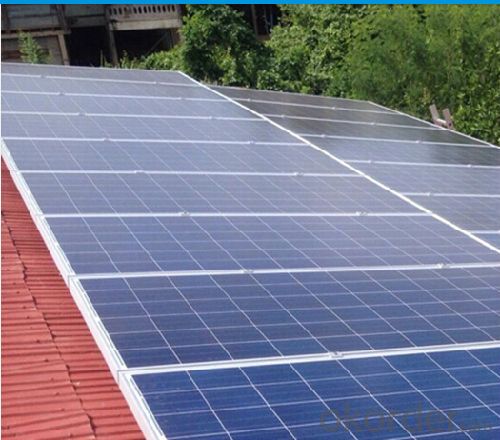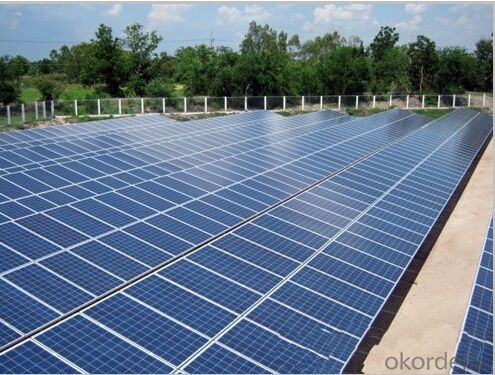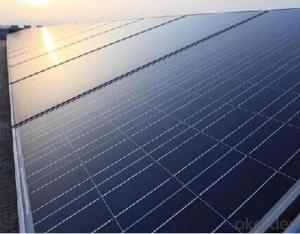Polycrystalline Silicon Solar Modules 72Cell-305W
- Loading Port:
- China Main Port
- Payment Terms:
- TT or LC
- Min Order Qty:
- 1000 watt
- Supply Capability:
- 10000000 watt/month
OKorder Service Pledge
OKorder Financial Service
You Might Also Like
1. Structure of Polycrystalline Silicon Solar Modules 72Cell-305W Description
Solar panels can be used as a component of a larger photovoltaic system to generate and supply electricity in commercial and residential applications.
-Tests by independent laboratories prove that modules:
Fully conform with certification and regulatory standards.
Withstand wind loads of up to 2.4kPa and snow loads of up to 5.4kPa, confirming mechanical stability.
Successfully endure ammonia and salt-mist exposure at the highest severity level, ensuring their performance in adverse conditions.
- High effi ciency, multicrystalline silicon solar cells with high transmission and textured glass deliver a module effi ciency of up to 16.0%, minimizing installation costs and maximizing the kWh output of your system per unit area.
- Tight positive power tolerance of 0W to +5W ensures you receive modules at or above nameplate power and contributes to minimizing module mismatch losses leading to improved system yield.
- Top ranking in the “TÜV Rheinland Energy Yield Test” and the “PHOTON Test” demonstrates high performance and annual energy production.
2. Main Features of the Polycrystalline Silicon Solar Modules 72Cell-305W
* WARRANTIES
- 10-year limited product warranty1.
- Limited power warranty1: 1 year at 98% of the minimal rated power
output, 10 years at 92% of the minimal rated power output, 25 years
at 82% of the minimal rated power output.
1In compliance with our Warranty Terms and Conditions.
*QUALIFICATIONS & CERTIFICATES
IEC 61215, IEC 61730, MCS, CE, ISO 9001:2008, ISO 14001:2004, BS OHSAS 18001:2007, PV Cycle, SA 8000
3. Polycrystalline Silicon Solar Modules 72Cell-305W Images



4. Polycrystalline Silicon Solar Modules 72Cell-305W Specification
Electrical parameters at Standard Test Conditions (STC)窗体底端 | |||
Power output | P max | W | 305 |
Power output tolerances | ΔP max | W | 0 / + 5 |
Module effi ciency | η m | % | 15.7 |
Voltage at Pmax | V mpp | V | 36.1 |
Current at Pmax | I mpp | A | 8.45 |
Open-circuit voltage | V oc | V | 45.4 |
Short-circuit current | I sc | A | 8.93 窗体底端 |
5. FAQ of Polycrystalline Silicon Solar Modules 72Cell-305W
(1) Can you offer the test report of the module?
Sure. All the solar modules must pass necessary tests including EL test and ultra-red test and other visual test of the apperance, and the test report presents all the detailed data of the modules.
(2) How to confirm about the quantity and the type of solar module?
It depends on the solar system where you want to put into use the solar modules. We have experienced engineers to design for your order and you need to give more information to fix the details.
(3) How long will you deliver the solar modules?
We need to purchase the materials according to the list confirmed by you and put into production, and we will do our best to get your satisfaction.
- Q:I have to show in a project (a model house) how Solar Panels work. In my model I want to show Solar Panels creating electricity to power a T.V but I need to show how the power gets from the Solar Panels to the T.V. A diagram would be really helpful. Please try and make this as simple as possible as I'm only 3, but try and be specific as well!
- Light consists of small packets of energy called photons. When photons with sufficient energy strike the photocell its energy is converted into electrical energy which is stored in the batteries as dc voltage. To run a TV an invertor is used which converts dc to ac. Now you can make a block diagram of it and present it TC
- Q:Are photovoltaic cells the same as solar panels?
- Homemade okorder /
- Q:Why is it nessicary, with today's economy in the postion it's currently in, to use renewable energy sources; like solar panels?
- They are not necessary, and you don't have to use them. However, the benefit of using solar panels is that you can make your own electricity at no cost. Yeah, of course, you need to spend some cash to build those panels, but once they are there, they will work like a charm, giving you free power.
- Q:i'm making a small solar panel powered fan but it cant run the cellphone vibration motor even i have place two x2 solar panel.
- this type of solar panel has some few watts. Ah is a quantity (which represent energy) that define the flow of ampere for a period of hour. so, the max instant electric current is 40mA and the max power is 40mA x 3.6 = 0.44 watts but, this value depends of the solar ilumination which the panel is subjected.
- Q:I am designing a solar panel but i need to have maximum power output.How can i optimize the equation for power Total power=voltage * current to get maximum power.
- first place the panel so it is at right angles to the solar rays. Make sure none of the panel has any shade whatsoever. For best results use motor drives to keep it in that position as the sun moves across the sky. For overall maximum versus time, you need to be near the equator. Solar cells have a high internal resistance, so for maximum power transfer, you need a load of that same resistance. A good charge controller will use DC-DC converters to provide that load. .
- Q:Maximum size of solar panel i have to use is - 8 * 5 feet - this is the limitation given to us.
- Just buy solar panel has output rated 500 watt.
- Q:So, I've seen cheap solar panel kits for sale from Harbor Freight, and regardless of whether or not I were to buy a set from them or someone else, I was wondering what the process of implementing a small-scale solar system into your household electrical system would be.I've read articles that started out too in-depth or were speaking of systems on a much larger scale.Can it be as easy as buying the panels and inverter, and plugging it into a socket, or is there more to it?Some of the articles I was reading had mentioned having to contract with your electrical supplier, having to have an electrician tie it all in in some special/ necessary way, using a battery pack (would this be necessary for a tied-in system?), or using the system to only power single items, like a water heater, or plugging items into a connected battery-pack, all of which I'm not sure is necessary or needed for what my goals/ means are/ would be.
- Take okorder /... This unit produces 45W for $90. Inverter is extra. Let's say this unit produces that amount of power for a full 2 hours a day, that's 45W * 2h = 540 Wh or 0.54kWh. If I save that from my electrical company, I would pay about 5 cents. $90 then takes 3800 days or 0 years. At that point, you haven't actually made any money, you've simply recovered what you paid out to buy the unit 0 years ago. Yes, electrical power prices will be going up over the long term but the output of this unit is also not going to be 45W over its lifetime (if it even lasts 0 years) so I really question the economics.
- Q:How much electricity does a solar panel produce?
- The amount of electricity a solar panel produces depends on various factors such as its size, efficiency, location, and weather conditions. On average, a standard-sized solar panel can generate around 250 to 400 watts of electricity per hour under optimal conditions. However, this output can vary significantly throughout the day and across different seasons.
- Q:I am curious about how much of the energy that a solar panel of a given size and capacity will produce in it's lifetime, and what fraction of that energy was required to produce it in the first place?
- At present the technology to create silicon solar cells is incredibly energy intensive. It is not logical to compare the cost of oil to the cost of a solar cell because they are not priced according to energy input. Oil has a strong advantage in that it is concentrated solar and geothermal chemical energy that has accumulated over millions of years. The price of oil does not reflect its energy content, but the cost to retreive it. Electrical energy used to produce a Photovoltaic cell is not priced in any proportion to oil. By some calculations it will take about 50,000 KWh of energy produced by the PV cell before it can recover the energy used to manufacture it.
1. Manufacturer Overview |
|
|---|---|
| Location | |
| Year Established | |
| Annual Output Value | |
| Main Markets | |
| Company Certifications | |
2. Manufacturer Certificates |
|
|---|---|
| a) Certification Name | |
| Range | |
| Reference | |
| Validity Period | |
3. Manufacturer Capability |
|
|---|---|
| a)Trade Capacity | |
| Nearest Port | |
| Export Percentage | |
| No.of Employees in Trade Department | |
| Language Spoken: | |
| b)Factory Information | |
| Factory Size: | |
| No. of Production Lines | |
| Contract Manufacturing | |
| Product Price Range | |
Send your message to us
Polycrystalline Silicon Solar Modules 72Cell-305W
- Loading Port:
- China Main Port
- Payment Terms:
- TT or LC
- Min Order Qty:
- 1000 watt
- Supply Capability:
- 10000000 watt/month
OKorder Service Pledge
OKorder Financial Service
Similar products
New products
Hot products
Related keywords































